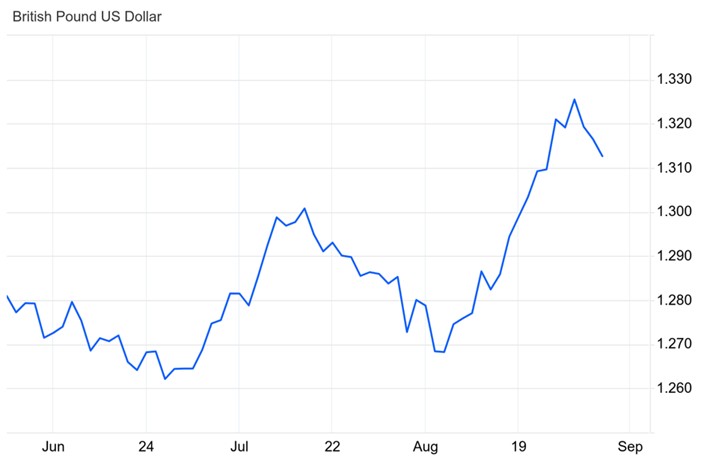GBP/USD Exchange rate hits two-year high in August
The pound began the month on the back foot following the Bank of England’s (BoE) interest rate decision on 1 August, causing it to fall below 1.28 against the dollar. The UK central bank delivered a 25-basis point interest rate cut, slashing rates from 16-year highs of 5.25%.
The pound dollar rate touched a four-week low just above 1.27 the following day in the wake of the BoE’s knife-edge interest rate decision that split the Monetary Policy Committee (MPC), with its members voting 5-4 in favour of the cut.
Market turbulence undermined the pound on 6 August, causing it to slump below 1.27 versus the euro, despite data showing an improvement in UK retail activity.
The pound dollar rate firmed on 8 August, rising above 1.27 amid market anxiety that dented the dollar.
The pair’s upward momentum saw it break through 1.28 following the publication of a robust jobs report that showed British unemployment unexpectedly fell in the three months to June. The dip from 4.4% to 4.2% defied analysts’ forecast that the jobless rate would rise to a fresh two-and-a-half-year high of 4.5%.
News of UK economic growth extended the pound’s gains on 15 August. The preliminary GDP reading for the second quarter showed the economy expanded by 0.6%, in line with market forecasts and modestly softening from a previous 0.7% pace of growth. The reading signalled that the economy is continuing to strengthen after briefly slipping into a technical recession at the end of 2023.
A rebound in UK retail sales saw the buoyant pound drift up towards a three-week high just shy of 1.29 the following day. The month-on-month figure reported a solid uptick in sales in July, rising from a previous reading of -0.9% to 0.5%, printing in line with market expectations – a return to growth that served to undermine BoE interest rate cut bets, lifting the pound in the process.
The pound dollar rate surged to a 13-month high above 1.30 on 20 August amid dollar weakness ahead of several speeches from Federal Reserve officials at the annual Jackson Hole Symposium.
The pair rose to a fresh yearly high on 23 August following comments by Federal Reserve Chair Jerome Powell at the central bank’s annual summit that signalled it will trigger its monetary easing cycle in September: “My confidence has grown that inflation is on a sustainable path back to 2%. The labour market has cooled considerably from its formerly overheated state. We do not seek or welcome further cooling in labour market conditions. The time has come for policy to adjust. The direction of travel is clear, and the timing and pace of rate cuts will depend on incoming data.”
Having topped out at 1.32 for the month – a two-year high – the pound slipped to 1.31 against the dollar on 28 August as UK economic uncertainty deterred investors from the pound.
Downbeat comments from PM Kier Starmer came hot on the heels of the UK government’s latest borrowing figures, which stoked concerns of a ‘black hole’ in public finances.
Starmer said: “I will be honest with you, there is a budget coming in October and it’s going to be painful. Just as when I responded to the riots, I’ll have to turn to the country and make big asks of you to accept short-term pain for long-term good. The difficult trade-off for the genuine solution.”
Starmer’s remarks fuelled concerns of a possible return to austerity in Britain later in the year.
The pound dollar exchange rate ended the month at 1.313.
GBPUSD: 3-Month Chart

Looking ahead
A second rate cut from the BoE looks unlikely in September against a backdrop of persistent wage growth and services inflation that’s likely to keep the MPC hawkish.
Influential data from the UK economy in September: ILO Unemployment Rate (10 September), Average Earnings Excluding Bonus (10 September), Consumer Price Index (18 September), Retail Sales (20 September), S&P Global/CIPS Composite PMI (24 September), GDP (30 September).
The Fed is poised to fire the starting gun on its policy easing cycle in September as inflation cools. If this widely expected move has been priced into the market, the dollar’s subsequent fall will be cushioned.
Influential data from the US economy in September: ISM Manufacturing PMI (3 September), ADP Employment Change (5 September), ISM Services PMI (5 September), Nonfarm Payrolls (6 September), Consumer Price Index (11 September), Producer Price Index ex Food and Energy (12 September), Michigan Consumer Sentiment Index (13 September), Retail Sales (17 September), S&P Global Composite (24 September), GDP (26 September), Core Personal Consumption Expenditures – Price Index (27 September).






